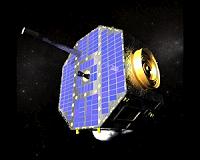 |
Los Angeles CA (SPX) Feb 15, 2010 A dramatic new image from the Gemini North telescope illustrates the dynamic and sometimes violent process of star birth. It also demonstrates the capabilities of new filters available to researchers using the Gemini Multi-Object Spectrograph (GMOS). Known as Sharpless 2-106 (Sh2-106), the hourglass-shaped nebula in the new Gemini image is a stellar nursery made up of glowing gas and light-scattering dust. The material shrouds a natal high-mass star thought to be mostly responsible for the hourglass (bipolar) shape of the nebula due to high-speed winds (at more than 200 kilometers/second) which eject material from the forming star deep within. Research also indicates that many sub-stellar objects are forming within the cloud and may someday result in a cluster of 50 to 150 stars in this region. The nebula is located about 2,000 light-years away in the direction of the constellation Cygnus. Its physical dimensions are about 2 light-years long by 1/2 light-year across. It is thought that its central star could be up to 15 times the mass of our Sun. The star's formation likely began no more than 100,000 years ago, and eventually its light will break free of the enveloping cloud as it begins the relatively short life of a massive star. The new filters provide valuable insights by transmitting very specific colors of visible light emitted by excited hydrogen, helium, oxygen, and sulfur as radiation from hot young birthing stars energize clouds of gas and dust. The filters are also used to study planetary nebulae and excited gas in other galaxies. For this image four colors were combined as follows: violet - helium II filter; blue - sulfur II filter; green - oxygen III filter; and red - hydrogen-alpha filter. Each filter was integrated for a total of 900 seconds. The seeing was 0.4 arcsecond RMS. The rotation of the image is 125 degrees CCW from north up, east to the left and the field of view is 3.87 arcminutes on each side. The original calibrated, science-grade data for this image is soon to be available to the astronomical community on the Gemini Science Archive. The image was obtained using the Gemini Multi-Object Spectrograph on the Gemini North telescope. An identical instrument and filter set is available at the Gemini South telescope in Chile for parallel capabilities on the southern sky. The new filters on GMOS are described and characterized for Gemini users. The Gemini Observatory is an international collaboration with two identical 8-meter telescopes. The Frederick C. Gillett Gemini Telescope is located at Mauna Kea, Hawai'i (Gemini North) and the other telescope at Cerro Pachon in central Chile (Gemini South), and hence provide full coverage of both hemispheres of the sky. Both telescopes incorporate new technologies that allow large, relatively thin mirrors under active control to collect and focus both optical and infrared radiation from space.
Share This Article With Planet Earth
Related Links Gemini Stellar Chemistry, The Universe And All Within It
 Giant Ribbon At The Edge Of The Solar System: Mystery Solved
Giant Ribbon At The Edge Of The Solar System: Mystery SolvedHuntsville AL (SPX) Jan 18, 2010 Last year, when NASA's IBEX (Interstellar Boundary Explorer) spacecraft discovered a giant ribbon at the edge of the solar system, researchers were mystified. They called it a "shocking result" and puzzled over its origin. Now the mystery may have been solved. "We believe the ribbon is a reflection," says Jacob Heerikhuisen, a NASA Heliophysics Guest Investigator from the University of Ala ... read more |
|
| The content herein, unless otherwise known to be public domain, are Copyright 1995-2010 - SpaceDaily. AFP and UPI Wire Stories are copyright Agence France-Presse and United Press International. ESA Portal Reports are copyright European Space Agency. All NASA sourced material is public domain. Additional copyrights may apply in whole or part to other bona fide parties. Advertising does not imply endorsement,agreement or approval of any opinions, statements or information provided by SpaceDaily on any Web page published or hosted by SpaceDaily. Privacy Statement |